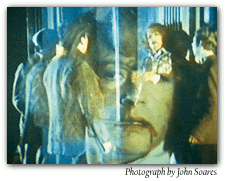Main Menu · Search ·Current Issue ·Contact ·Archives ·Centennial ·Letters to the Editor ·FAQs


| Lethal Odds | Men in Makeup |
| Cult Hormone | Edges of History |
| The Dying in Moscow | Cantering Fantasies |
| E-mail and Web Information | |
 |
| Gay-bashers assault Quentin Crisp (John Hurt) in the 1980 film "The Naked Civil Servant" |